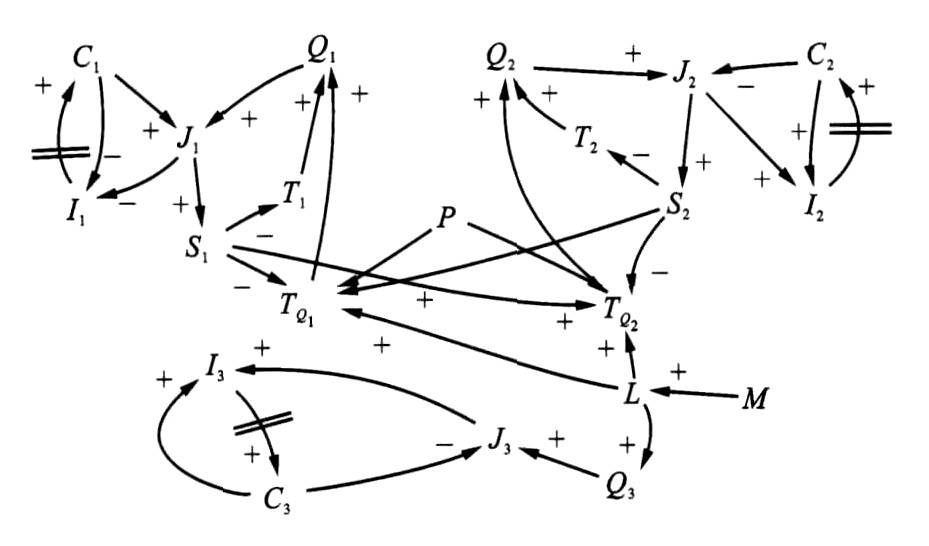Dynamics analysis model of port group logistics system in Yangtze River Delta
Article Text (Baidu Translation)
-
摘要: 为了实现长江三角洲港口群物流系统的协调发展, 建立了系统动力学分析模型。通过分析上海和宁波两港口国际集装箱中转量、港口群水路集疏运比例的影响因素, 建立长江三角洲港口群物流系统的因果关系图, 通过系统模拟进行长江三角洲地区港口功能的合理定位、集疏运结构的优化和近洋航线中转港的选择。仿真结果表明: 2010年上海港国际集装箱中转量将呈现增长趋势, 上海港水路集疏运比例超过30%, 长江三角洲地区应以上海港为集装箱枢纽港, 优先发展国际中转业务, 太仓港将具备长江三角洲近洋航线中转港的能力, 太仓港可成为长江三角洲地区近洋航线主要中转港。Abstract: In order to realize the coordination development of port group logistics system in Yangtze Rive Delta (YRD), a dynamics model of the system was set up.The effect factors of international container transshipment volume and waterway transportation percentage at Shanghai Port and Ningbo Port were analyzed, the cause-effect relation graphs of the system were constructed, the system was simulated and the rational orientation of port function, the structural optimization of transportation system and transshipment port choice of near sea routes were studied.Simulation result shows that there will be an increase trend of international container transshipment volume in Shanghai Port in 2010, its waterway transportation percentage will be more than 30%, so it should be developed as a container hub port to expand international transshipment business; Taicang Port can be developed as a main transshipment port in near sea routes resulted from possessing the ability of container transshipment.
-
表 1 系统参数
Table 1. System parameters
参数 意义 C1、C2、C3、C4/TEU 港口1、2、3和4的吞吐能力 RC1、RC2、RC3、RC4/TEU 港口1、2、3和4吞吐能力年变化量 Q1、Q2、Q3、Q4/TEU 港口1、2、3和4吞吐量 P1、P2、P3、P4/TEU 港口1、2、3和4计划吞吐能力 I1、I2、I3、I4/TEU 港口1、2、3和4计划新增吞吐能力 J1、J2、J3、J4 港口1、2、3和4拥挤度(吞吐量/吞吐能力) PJ1、PJ2、PJ3、PJ4 港口1、2、3和4计划拥挤度(吞吐量/计划吞吐能力) T1、T2/TEU 港口1、2的国际中转集装箱吞吐量 A1、A2 港口1、2的国际中转集装箱吸引力 S1、S2/d 港口1、2的船舶在港时间 TQ1、TQ2/TEU 腹地货物选择在港口1、2中转而给港口1、2带来的吞吐量 L1、L2、L3/TEU 港口1、2、3腹地货源生成量 P/(元·TEU-1) 各种集疏运路径的阻抗 M1、M2、M3/亿美元 上海市、长江三角洲江苏部分、长江三角洲浙江部分对外贸易量 RM1、RM2、RM3/(亿美元·a-1) M1、M2、M3对应的年度变化量 B1、B4、B5、B6、B7、B8 区域内集装箱选择路径1、4、5、6、7和8进行集疏运的比例 B 整个区域内集装箱水路集疏运比例 W/TEU 长江水路集装箱运量 r1、r2、r3 M1、M2、M3对应的年度增长率 X1、X2、X3 上海市、长江三角洲江苏部分、长江三角洲浙江部分外贸集装箱生成系数 Z 地域因子, 表示杭州、嘉兴、湖州、绍兴地区外贸额占长江三角洲浙江地区外贸额比例 w3 港口3的外贸比例因子 h1、h2 腹地因子, 表示长江三角洲地区对港口1、2外贸集装箱吞吐量的贡献比例 z1、z2 港口1、2的外贸重箱比例因子 z4 近洋航线重箱比例因子 R 系统运行时间变化 t/a 系统运行时间 p1/(元·TEU-1) 长江三角洲近洋航线集装箱选择水路集疏运至中转港的集疏运阻抗 p2/(元·TEU-1) 长江三角洲近洋航线集装箱选择公路集疏运至中转港的集疏运阻抗 b1 长江三角洲近洋航线集装箱选择水路集疏运的比例 Qs/TEU 长江三角洲近洋航线集装箱水路集疏运运量 Y4/d 水路集疏运运输时间 表 2 综合运价
路径 1 2 3 4 5 6 7 8 综合运价 300 480 — 1 000 1 600 1 440 1 580 1 200 表 3 集装箱吞吐量预测值与实际值比较

-
[1] 马立宏, 张文杰. 区域物流发展现状及对策研究[J]. 中国流通经济, 2002, 16(4): 14-16. doi: 10.3969/j.issn.1007-8266.2002.04.004Ma Li-hong, Zhang Wen-jie. Research on the states and improvement measures of area logistics[J]. China Business and Market, 2002, 16(4): 14-16. (in Chinese) doi: 10.3969/j.issn.1007-8266.2002.04.004 [2] 华蕊. 区域物流与区域经济的关系[J]. 物流科技, 2004, 28(9): 78-79. doi: 10.3969/j.issn.1002-3100.2004.09.024Hua Rui. The relation of regional logistics and regional economy[J]. Logistics Management, 2004, 28(9): 78-79. (in Chinese) doi: 10.3969/j.issn.1002-3100.2004.09.024 [3] 李玉民, 李旭宏, 毛海军, 等. 基于主成分分析的区域物流综合评价及发展战略[J]. 交通运输系统工程与信息, 2004, 4(2): 91-95. doi: 10.3969/j.issn.1009-6744.2004.02.018Li Yu-min, Li Xu-hong, Mao Hai-jun, et al. Study on comprehensive evaluation and development strategy of regional logistics based on principal component analysis[J]. Journal of Transportation Systems Engineering and Information Technology, 2004, 4(2): 91-95. (in Chinese) doi: 10.3969/j.issn.1009-6744.2004.02.018 [4] 吴坚, 史忠科. 区域物流系统的优化模型[J]. 华南理工大学学报: 自然科学版, 2004, 32(8): 68-71. doi: 10.3321/j.issn:1000-565X.2004.08.017Wu Jian, Shi Zhong-ke. Optimization model of the arealogistics system[J]. Journal of South China University of Technology: Natural Science Edition, 2004, 32(8): 68-71. (in Chinese) doi: 10.3321/j.issn:1000-565X.2004.08.017 [5] 李春海, 缪立新. 区域物流系统及物流园规划方法体系[J]. 清华大学学报: 自然科学版, 2004, 44(3): 398-401. doi: 10.3321/j.issn:1000-0054.2004.03.038Li Chun-hai, Miao Li-xin. Planning methods of regional logistics system and logistics parks[J]. Journal of Tsinghua University: Science and Technology, 2004, 44(3): 398-401. (in Chinese) doi: 10.3321/j.issn:1000-0054.2004.03.038 [6] 田青, 缪立新, 郑力. 基于运输规划和组合GA的基本物流网络设计[J]. 清华大学学报: 自然科学版, 2004, 44(11): 1 441-1 444. doi: 10.3321/j.issn:1000-0054.2004.11.003Tian Qing, Miao Li-xin, Zheng Li. Logistics network designbased ontransport planning and combined GA[J]. Journal of Tsinghua University: Science and Technology, 2004, 44(11): 1 441-1 444. (in Chinese) doi: 10.3321/j.issn:1000-0054.2004.11.003 [7] Zapfel G, Wasner M. Planning and optimization of hub-and-spoke transportation networks of cooperative third party logistics providers[J]. International Journal of Production Economics, 2002, 78(2): 207-220. [8] 吴群琪, 孙启鹏. 综合运输规划理论的基点[J]. 交通运输工程学报, 2006, 6(3): 122-126. doi: 10.3321/j.issn:1671-1637.2006.03.026Wu Qun-qi, Sun Qi-peng. Basic point of integrated transportation planning theory[J]. Journal of Traffic and Transportation Engineering, 2006, 6(3): 122-126. (in Chinese) doi: 10.3321/j.issn:1671-1637.2006.03.026 [9] 杨乐能. 系统动力学在长江三角洲集装箱港口竞争策略决策中的应用研究[D]. 上海: 上海海运学院, 1999. [10] Lai C L, Lee WB. The system dynamics model for engineering services[J]. Managing Service Quality, 2001, 11(3): 191-199. [11] 冷秀斌. 基于系统动力学的中国石油进出口海运量研究[D]. 大连: 大连海事大学, 2003. [12] Kolay M K. Managing working capital crises: a system dynamics approach[J]. Management Decision, 1991, 29(5): 75-78. [13] 宋炳良. 长江三角洲经济辐射力与东西部大通道[J]. 同济大学学报: 社会科学版, 2003, 14(1): 96-100. https://www.cnki.com.cn/Article/CJFDTOTAL-TJDS200301016.htmSong Bing-liang. The Yangtze Delta s economic radiation andthe great passageway bridging East and West China[J]. Journal of Tongji University: Social Science Section, 2003, 14(1): 96-100. (in Chinese) https://www.cnki.com.cn/Article/CJFDTOTAL-TJDS200301016.htm [14] 蔡正荣. 方兴未艾的长江集装箱运输[J]. 集装箱化, 2005, 16(5): 5-8. https://www.cnki.com.cn/Article/CJFDTOTAL-JZXH200505004.htmCai Zheng-rong. Emerging of Yangtze River container transportation[J]. Containerization, 2005, 16(5): 5-8. (in Chinese) https://www.cnki.com.cn/Article/CJFDTOTAL-JZXH200505004.htm [15] 黄郎辉, 杨京英. 长江与珠江三角洲及港澳特别行政区统计年鉴(2005)[M]. 北京: 中国统计出版社, 2005. [16] 徐建华. 华东地区集装箱运输发展前景及合理运输系统论证[R]. 上海: 上海海事大学, 1999. [17] 汪传旭. 国际集装箱生成机制与箱务管理研究[D]. 上海: 复旦大学, 2000. -





 下载:
下载:











